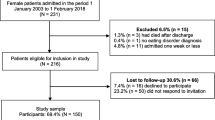Abstract
The goal of this study was to analyze the impact of obsessive compulsive behaviors (OCB) in eating disorder males and females admitted for residential treatment in terms of length of stay and severity of symptoms. Patients (N=384) were separated into four groups based on gender and the score obtained for the Maudsley Obsessive-Compulsive Inventory at admission. The instrument used to assess severity of eating disorder symptoms was the Eating Disorder Inventory (EDI-2) at admission and discharge. The results showed that the presence of comorbid OCB in eating disordered males and females account for longer length of stay (LOS) and an increased severity of eating disorder symptoms. Clinically, these findings point to the need for development of more targeted residential programs that are equipped for and adept at treating the comorbid eating disorder/OCB patient population.
Similar content being viewed by others
References
Milos G., Spindler A., Ruggiero G., Klaghofer R., Schnyder U.: Comorbidity of obsessive-compulsive disorders and duration of eating disorders. Int. J. Eat. Disord., 31, 284, 2002.
Fisher M., Fornar V., Waldbaum R., Gold R.: Three case reports on the relationship between anorexia nervosa and obsessive compulsive disorder. Int. J. Adolesc. Med. Health, 14, 329, 2002.
Lennkh C., Strnad A., Bailer U., Biener D., Fodor G., de Zwaan M:: Comorbidity of obsessive compulsive disorder in patients with eating disorders. Eat. Weight Disord., 3, 37, 1998.
Cassidy E., Allsopp M., Williams T.: Obsessive compulsive symptoms at initial presentation of adolescent eating disorders. Eur. Child Adolesc. Psychiatry, 8, 193, 1999.
Tadai T., Nakamura M., Okazaki S., Nakajima T.: The prevalence of obsessive-compulsive disorder in Japan: a study of students using the Maudsley Obsessional- Compulsive Inventory and DSM-III-R. Psychiatry Clin. Neurosci., 49, 39, 1995. javascript:PopUp Menu2_Set(Menu8608432)
Emmelkamp P.M., Kraaijkamp H.J., van den Hout M.A.: Assessment of obsessive-compulsive disorder. Behav. Modif., 23, 269, 1999.
Garner D.M., Olmsted M.P., Polivy J.: Development and validation of a multidimensional Eating Disorder. Inventory for anorexia nervosa and bulimia. Int. J Eat. Disord., 2, 15, 1983.
Bean P., Loomis C.C., Timmel P., Hallinan P., Moore S., Mammel.J, Weltzin T.: Outcome variables for anorexic males and females one year after discharge from residential treatment. J. Addict. Dis., 23, 83, 2004.
Bean P., Weltzin T.E.: Evolution of symptoms severity during residential treatment of females with eating disorders. Eat. Weight Disord., 6, 197, 2001.
Garner D.M.: Eating Disorder Inventory — 2, Professional Manual. Psychological Assessment Resources, Inc. P.O. Box 998, Odessa, Florida 33556.
Matsunaga H., Kiriike N., Miyata A., Iwasaki.Y, Matsui T., Fujimoto K., Kasai S., Kaye W.H:. Prevalence and symptomatology of comorbid obsessive compulsive disorder among bulimic patients. Psychiatry Clin. Neurosci., 53, 661, 1999.
Hudson J.I., Pope H.G. Jr, Jonas J.M., Yurgelun-Todd D.: Phenomenologic relationship of eating disorders to major affective disorder. Psychiatry Res., 9, 345, 1983.
Speranza M., Corcos M., Godart N., Jeammet P., Flament M.: Current and lifetime prevalence of obsessive compulsive disorders in eating disorders. Encephala, 27, 541, 2001.
Speranza M., Corcos M., Godart N., Loas G., Guilbaud O., Jeammet P., Flament M.: Obsessive compulsive disorders in eating disorders. Eat. Behav., 2, 193, 2001.
Bean P., Maddocks M.B., Timmel P., Weltzin T.: Gender differences in the progression of co-morbid psychopathology symptoms of eating disordered patients. Eat. Weight Disord., 10, 168, 2005.
Stewart S.E., Stack D.E., Farrell C., Pauls D.L., Jenike M.A.: Effectiveness of intensive residential treatment (IRT) for severe, refractory obsessive-compulsive disorder. J. Psychiatr. Res., 39, 603, 2005.
Grabe J.H., Thiel A., Freyberger J.H.: Symptoms of eating disorders in obsessive compulsive disorder. Acta Psychiatr. Scand., 162, 449, 2000.
Author information
Authors and Affiliations
Corresponding author
Rights and permissions
About this article
Cite this article
Weltzin, T., Cornella-Carlson, T., Weisensel, N. et al. The combined presence of obsessive compulsive behaviors in males and females with eating disorders account for longer lengths of stay and more severe eating disorder symptoms. Eat Weight Disord 12, 176–182 (2007). https://doi.org/10.1007/BF03327595
Received:
Accepted:
Published:
Issue Date:
DOI: https://doi.org/10.1007/BF03327595




